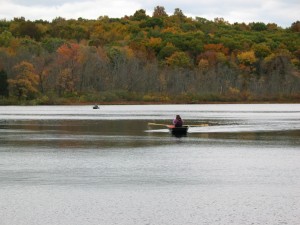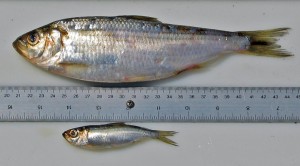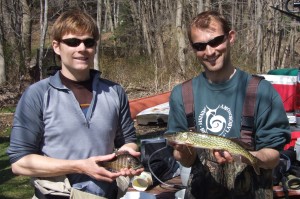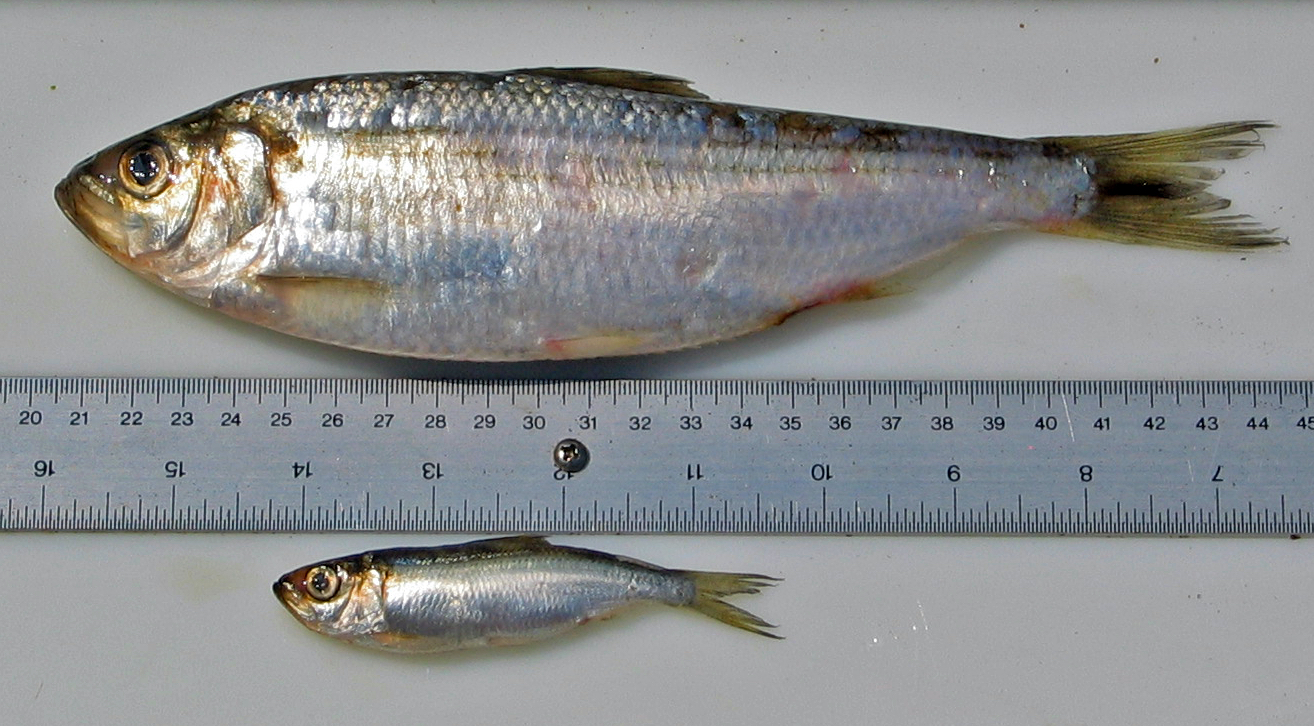Late October, twilight, Gorton Pond. The water lies still, reflecting the pitch-black night sky and the outlines of the fiery orange autumnal trees bordering the shore. The pond’s alewife juveniles are preparing for their migration to sea as their six-month stay in the freshwater pond comes to an end.
Four miles north of Gorton Pond, Pattagansett Lake has a similar environment and population of fishy residents, including alewife and their predators, the chain pickerels. But unlike Gorton Pond’s inhabitants, Pattagansett’s cannot migrate; Pattagansett is a landlocked lake.
These two bodies of water would have had almost identical ecologies and fauna a few hundred years ago. But European colonists in southern Connecticut built permanent dams, disconnecting lakes like Pattagansett from the sea. Within these dammed lakes, landlocked fish populations have since evolved in ways that spark the interest of ecologists and biologists alike. Among these curious scientists is Yale’s David Post, a professor of ecology and evolutionary biology.
Over the past decade, Post’s team of researchers has studied the alewife and chain pickerel populations in 12 lakes including Gorton and Pattagansett. The group’s most recent paper, published in the journal Nature, showed that changes in the alewife population can drive diversification and adaptation in the pickerel population. This is a departure from ecology’s traditional focus on the trickle-down impact that predators have on prey. Rapid predator evolution, occurring over a short time span, can be difficult to observe. But the Connecticut lakes conveniently exhibit isolated predator-prey systems, enabling the recent Post lab study and others like it. Research on alewife and pickerel fish is providing revolutionary insight into the predator-prey relationship in reverse.

A split history
Post first began studying alewife in 2004 after he recognized that there are two forms of alewife that are quite literally defined by their ecologies: The anadromous form migrates to the sea, and the landlocked form cannot migrate and is restricted to its home lake.
The anadromous fish of Gorton Pond and the landlocked fish of Pattagansett Lake were at one point the same population of migrating, anadromous alewife. Anadromous fish are born in freshwater areas and migrate to saltwater environments, returning to freshwater lakes and rivers only later in life to spawn a new cycle of migration. It was not until after the construction of manmade dams that alewife trapped inside Pattagansett began to evolve in isolation while Gorton Pond’s anadromous alewife continued to migrate. The ecological isolation affected a trend of increasing divergence between the two populations. Distinctions between the two types of fish would become apparent across New England over the next 300 years.
One component of this divergence is habitat. Any body of water — marine or fresh — is divided into distinct regions such as the littoral and pelagic zones, which differ in their chemical makeup and species composition. The near-shore littoral zone rings the lake and contains many unique habitats because of its numerous distinct species of rooted plants and animals. Meanwhile, the pelagic zone is what is considered open water, in which structure is defined by the thermocline, or the temperature gradient across varying depths. Because temperature drastically affects the amount of oxygen and nutrients dissolved in the water, the thermocline can impact the biology of the organisms living in the various layers of a pelagic habitat.
In every lake observed by Post and his colleagues, anadromous alewife lived in both the littoral and pelagic zones during their freshwater phase, whereas landlocked alewife lived exclusively in the pelagic zone. Although the reason for this choice of habitat remains unknown, the effects of this pelagic lifestyle are apparent in the alewife’s physical characteristics. The landlocked fish have comparatively smaller heads and more fusiform body shapes, such that their bodies are widest in the middle but taper off at the ends. This streamlined, tuna-shaped body allows them to swim faster in the pelagic zone, where speedy hunting and escape skills are necessary for survival.
Such landlocked populations are gold mines for evolutionary biologists, since isolation offers insight into a species’ rapid evolution as well as the effect of this evolution on other populations in the environment. After showing that alewives drove evolution in their prey, a plankton species, and in one of their niche competitors, the bluegill, Post decided to study the trickle-up impact of these divergent fish populations on their predators, the chain pickerel.

Nice to eat you
In the lakes that Post’s team was studying, the chain pickerel is the native top predator, or the keystone predator. Keystone predators play a crucial role in the food chain and ecology of their local habitat. In the lakes examined, pickerel prey not only on alewife, but also on yellow perch and sunfish — larger fish native to the littoral habitat.
Traditionally, the chain pickerel stays in the littoral habitat, where it hovers camouflaged among the plants, waiting for the opportune moment to lunge at its prey. Its body structure is long and arrow-like, making it especially advantageous for the pickerel to strike from a hiding place, but not at all for it to swim at length in open water.
It was thus surprising when the team found pickerel in the pelagic zone of several lakes home to landlocked alewives. Furthermore, the pelagic pickerel ate pelagic alewife almost exclusively, as discovered from stable isotope signature studies. These studies showed that the carbon isotope ratios in the pelagic pickerels were far more similar to the ratios found in pelagic alewife than those of any other prey species, indicating that the pickerel’s long-term diet had changed to include a higher proportion of alewife.
On the other hand, in lakes with anadromous alewife or no alewife, the team found no pelagic pickerel. Since anadromous alewife is only available a few months of the year, it is not worth it for the pickerel in these well-connected lakes to shift its habitat for a few extra temporary alewife. However, in lakes with a consistent landlocked alewife population, the pickerel adapts to eat more of the landlocked alewife. “They’ve made this novel niche shift because there are alewife in the middle of the lake, all the time,” Post said.
At an average of only 10 inches long, the alewife is a much more appealing meal than the jumbo-sized sunfish.
Keystone to success
Of course it is not only the pickerel’s diet that has changed. When Post’s researchers studied the morphology of the species, they found that pelagic pickerel had deeper, more fusiform body shapes as compared to their littoral counterparts — the same adaptation that they noticed in landlocked alewives, which also adapted to open-water lifestyles.
Lipid composition, or fattiness, in fish tissue also betrayed a striking difference between littoral and pelagic pickerel. Open-water pickerel had much higher lipid content than did near-shore pickerel. Post offered two reasons for this observation: First, the alewife has higher lipid content relative to the pickerel’s other prey. Eating more alewife thus causes greater lipid content for pickerel as well. Second, a landlocked alewife population offers a much more stable source of food than would a nomadic population of the same species. As a result, the pelagic pickerel eats more of its prey.
Lipid content is a significant measure of evolutionary adaptation. A higher lipid content can boost a fish’s health in several ways. More lipids allow a fish to survive fasting or invest more in growth and reproduction, improving the evolutionary fitness of the organism. Come wintertime when lakes freeze, lipid reserves can substantially reduce mortality by allowing fish to store energy and brave the cold.

Feeding back to ecology
For the next 10 to 20 years, Post intends to carry out a subsequent stage of the alewife project: combining the landlocked and anadromous alewife populations to see how such a disruption affects the evolution of the fish. In fact, the researchers have already installed fish ladders on many dams, allowing anadromous alewife to cross over into landlocked lakes.
Post believes that his lab’s work demonstrates the idea of feedback in evolution. “Our work is suggesting that the way in which organisms structure their environment can create a feedback that then drives their own evolution, which then changes the way they structure their environments. We call that an eco-evolutionary feedback between ecology and evolution,” he said. “The pickerel work, along with the work on bluegill and [plankton], shows that this kind of feedback can propagate throughout the food web.”
Notably, this study also provides insight into rapid evolutionary relationships between predator and prey. Classic rapid evolution research claims that mortality is the driving force of evolution: fishing and predatory pressure are both methods of selection. But the Post lab study is among the first to show the powerful bottom-up influence that prey species can have on keystone predators. Quite literally, this work is upturning the way we understand eco-evolutionary interactions between predators and prey.
Extra Reading:
- Brodersen, Jakob, Jennifer G. Howeth, and David M. Post. “Emergence of a Novel Prey Life History Promotes Contemporary Sympatric Diversification in a Top Predator.” Nat Comms 6 no. 8115 (2015). doi:10.1038/ncomms9115
- Jones, A. W., Palkovacs, E. P. & Post, D. M. Recent parallel divergence in body shape and diet source of alewife life history forms. Ecol.27, 1175–1187 (2013).
- Brooks, J. L., and S. I. Dodson. “Predation, Body Size, and Composition of Plankton.” Science3692 (1965): 28-35. doi: 10.1126/science.150.3692.28
About the Author: Sonia Wang is a sophomore molecular biophysics & biochemistry and economics double major in Jonathan Edwards College. She is the advertising manager for this magazine and spent her summer researching tsetse fly olfaction in the John Carlson lab.

